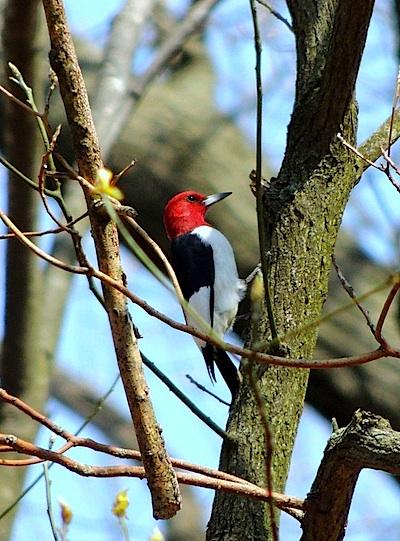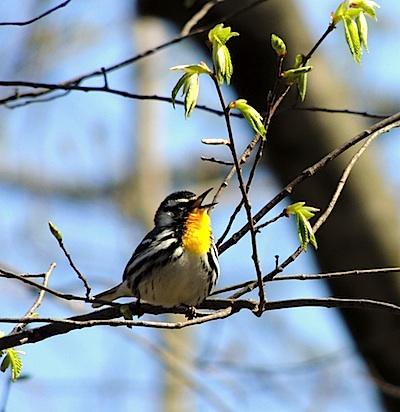
Red-headed Woodpeckers are quite common in the forests of Indiana Dunes National Lakeshore/Kirby Adams
It seems as though I hear about a new birding festival every month or so these days. Towns, businesses, and parks are starting to realize the economic clout of birders and are responding by creating to events to attract those birders and their money. To the chambers of commerce that money means profits at local businesses. To the parks, friends groups, and NGO's it can mean much needed support for critical conservation projects.
I don't see any downside to having more and more festivals. It's true that in much of the country, these events are clustered around a five- to six-week period in April and May, so they are definitely competing for attendees. Still, the pool is huge and growing bigger by the day. Many of the field trips and programs at festivals cater to new birders or simply general nature enthusiasts. These are not people who are going to fly from Chicago to Maine for the annual festival at Acadia, but they very well might slip over to Indiana Dunes National Lakeshore for the weekend.
Coincidentally, that's where the newest spring migration festival is this May. The inaugural Indiana Dunes Birding Festival will be May 7-10 in and around the national lakeshore and the closely associated Indiana Dunes State Park. James Currie, host of Nikon's Birding Adventures TV on NatGeo Wild will deliver the keynote address. If you haven't seen his show, you should. James puts the adventure in adventure birding. His talk is bound to be wildly entertaining.
Of course, a birding festival is first and foremost about the birding. Indiana Dunes is not lacking in that department any time of year, but the spring is particularly spectacular. Migrants swooping up the Mississippi flyway run into the bottom of Lake Michigan and tend to take a breather before selecting Wisconsin's sunrise coast or Michigan's sunset coast to continue their journey. (Those heading through Michigan may pass through Sleeping Bear Dunes National Lakeshore and be spotted by attendees of the Leelanau Birding Festival later in May. The Wisconsin flocks might stop at Apostle Islands National Lakeshore where some birders from the Chequamegon Bay Birding & Nature Festival may be visiting in mid May.)
The bonus at Indiana Dunes is that you're at the northern extreme of the range for some southern nesting birds that can be spotted alongside the northern migrants passing through. The Blackburnian Warbler, denizen of boreal conifer forests can be frolicking with Yellow-throated Warblers that are typical of sycamore-lined wetlands in the southeast.
Evening hikes during the festival will focus on owls and nightjars, with the chance that some participants might get to see a banding demonstration of the weird and mysterious Eastern Whip-poor-will.
One thing I like to see with many of these festivals is hikes and activities that may be only tangentially related to birds. Photography is all the rage in birding and nature appreciation these days, and the Indiana Dunes festival has responded with three photography workshops. One hike is focused solely on wildflowers, though the hikers will no doubt take note of at least a few birds. I've never been on a botany hike where eyes didn't drift upwards when a bird sang, nor vice versa when a birding walk passes a patch of trillium.

Birders to the upcoming festival at Indiana Dunes National Lakeshore just might spot a Yellow-throated Warbler/Kirby Adams
Speaking of wildflowers, the Heron Rookery portion of Indiana Dunes National Lakeshore provides one of the best spring nature walks in America, in my humble opinion. The Heron Rookery is a section of the park south of I-94, offset from the coastal parts of the national and state parks. It's a level and easy walk along the East Arm of the Little Calumet River. The moist forest is blanketed with spring wildflowers and the Sycamores lining the river are dripping with birds. It's also not a bad spot for salamanders, frogs, and snakes, for the herpetologically inclined. The festival offers a field trip to the rookery that should be a must-see for everyone.
If I had to associate just a couple birds with Indiana Dunes, I think it would be the resident Yellow-throated Warblers of the Heron Rookery and the Red-headed Woodpeckers of the forested side of the dunes. The woodpeckers are ubiquitous in the wooded portions of the park, one of the best spots in the country to see them. Every time I see one take off through the trees, I'm reminded of the old riddle asking 'what's black and white and red all over?' It's not a newspaper ' it's a Red-headed Woodpecker. They present a stark banner of solid white and black patches when they fly, with that brilliant red head flashing in and out of sight as they wind through the forest. It's one of the best sights in birding and it's all yours at Indiana Dunes.



Comments
The neat combination of birdwatching and flora gazing that you mention is something that can be readily done by visitors to the Acadia Birding Festival. Late May, when the festival is going on, is also a great time to see the Wild Gardens of Acadia and other area gardens - including one designed to attract butterflies. And this is a less crowded time to visit. Here’s a link to our blog post of some of these springtime activities: http://www.acadiaonmymind.com/2015/03/hope-springs-eternal-for-springtim...